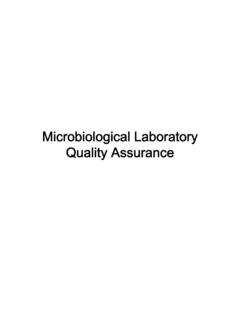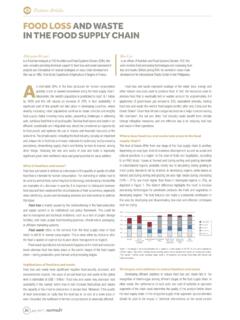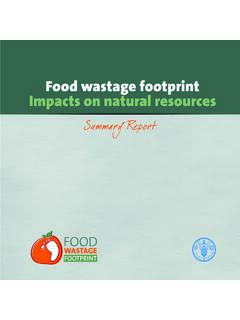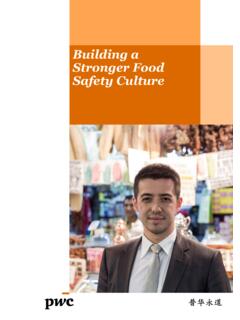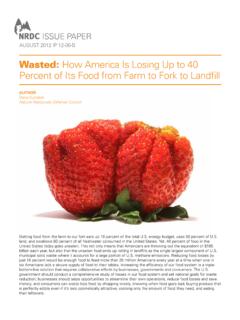Transcription of Prerequisite Programs: Minimizing Food Safety Hazards ...
1 Prerequisite Programs: Minimizing food Safety Hazards Along the food supply ChainGood Agricultural Pr actices (GAPs)Good Manufacturing Practices (GMPs)Sanitation and HygieneNovember 6, 2010Dr. Leslie BourquinDr. Deepa ThiagarajanMichigan State Uni versityPresentation Outline Introduction to Prerequisite Programs Good Agricultural Practices Good Manufacturing Practices Sanitation and Hygiene Exercise2 food HygieneCODEX Definition: All conditions and measures necessary to ensure the Safety and suitability of food at all stages of the food : CAC/RCP 1-1969, 20033 Prerequisite ProgramCODEX Definition.
2 A program that is required prior to the application of the HACCP system to ensure that a [fish and shellfish processing] facility is operating according to the Codex Principles of food Hygiene, the appropriate Code of Practice and appropriate food Safety : CAC/RCP 52-20034 Prerequisite Programs Effective implementation of Prerequisite programs (PRPs) is essential to establish a sound foundation prior to application of HACCP or other food Safety management systems. Ineffective implementation of PRPs will likely lead to ineffective implementation of HACCP (Hazard Analysis and Critical Control Point) Pr ograms are the Foundation of an Effecti ve food Safety SystemHACCPS anitation Standard Operating ProceduresPrerequisite Programs (GAPs, GMPs, GHPs, etc.)
3 6 Good Agricultural Practices7 Good Agricultural Practices Recommended practices for primary production of foodstuffs ( fruits and vegetables, cereals and legumes, livestock, fish and shellfish). Primary Production (defined) Those steps in the food chain up to and including, for example, harvesting, slaughter, milking, : CAC/RCP 1-1969, 20038 Normative Documents GAP s Codex Alimentarius Commission Code of Practice for Fish and Fishery Products (CAC/RCP 52 2003) [Principle focus on harvest and post harvest handling.]
4 ] Codex Alimentarius Commission Code of Hygienic Practice for Fresh Fruits and Vegetables (CAC/RCP 53 2003) Codex Alimentarius Commission Recommended Code of Practice on Good Animal Feeding (CAC/RCP 54 2004) Several other Codex standards also apply to primary : General Principles of food Hygiene Primary Production Primary production should be managed in a way that ensures that food is safe and suitable for its intended use. Where necessary, this will include: avoiding the use of areas where the environment poses a threat to the Safety of food controlling contaminants, pests and diseases of animals and plants in such a way as not to pose a threat to food Safety adopting practices and measures to ensure food is produced under appropriately hygienic : CAC/RCP 1-1969, General Principles of food Hygiene Primary Production Rationale.
5 To reduce the likelihood of introducing a hazard which may adversely affect the Safety of food , or its suitability for consumption, at later stages of the food chain . Primary Considerations at Primary Production: Environmental Hygiene Hygienic Production of food Sources Handling, Storage and Transport Cleaning, Maintenance and Personnel Hygiene at Primary ProductionSource: CAC/RCP 1-1969, Areas noted under CAC/RCP 52 2003 Code of Practice for Fish and Fishery Products Fishing and Harvesting Vessel Design and Construction Facility Design and Construction Design and Construction of Equipment and Utensils Hygiene Control Program Personal Hygiene and Health Transportation Product Tracing and Recall Procedures Training Focus primarily on harvest and post harvest.
6 Aquaculture is not really Feeding Areas noted under CAC/RCP 54 2004 Code of Practice on Good Animal Feeding General Principles and Requirements Feed ingredients Labeling Traceability/product tracing and record keeping of feed and feed ingredients Inspection and control procedures Health Hazards associated with animal feedSource: CAC/RCP 54-200413 Animal Feeding Production, Processing, Storage, Transport and Distribution of Feed and Feed Ingredients Premises Receiving, storage and transportation Personnel training Sanitation and pest control Equipment performance and maintenance Manufacturing controls RecallsSource.
7 CAC/RCP 54-200414 Animal Feeding On Farm Production and Use of Feed and Feed Ingredients Agricultural production of feed Manufacturing of feed on farm Good animal feeding practice Stable feeding and lot/intensive feeding units Aquaculture (refers only to CAC/RCP 52 2003)Source: CAC/RCP 54-200415 GAPs for Fresh F ruits and Vegetables CAC/RCP 53 2003 Code of Hygienic Practice for Fresh Fruits and Vegetables Primary Production Packing Establishment: Design and Facilities Control of Operation Packing Establishment: Maintenance and Sanitation Packing Establishment.
8 Personal Hygiene Transportation Product Information and Consumer Awareness Training16 USFDA Good Agricultural Practices 1998 FDA guidance document developed by the US food and Drug Administration Guide to Minimize Microbial food Safety Hazards for Fresh Fruits and Vegetables Not a federal regulation guidelines only Good Agricultural Practices The guide provides general advice for the fresh fruit and vegetable industry. Focus on Risk Reduction Not Risk Elimination Elements of The Guide Water Manure and Municipal Biosolids Worker Health and Hygiene Sanitary Facilities Field Sanitation Packing Facility Sanitation Transportation Traceback18 Commodity Specific GAPs Guidance Documents US Ex amples Tomatoes Melons Leafy Greens California Leafy Greens Marketing Agreement Standards Industry led standards for food Safety assurance Generally rely on third party audits for monitoring Numerous private food Safety schemes
9 Exist Several schemes have been benchmarked for equivalence by GFSI and other organizations Accredited schemes likely are more robust than non accredited schemes The scope of several private standards extends beyond food Safety ( environment, social responsibility)20 GlobalGAP Integrat ed Farm Assurance Standard21 PREVENTION is the Key to Re ducing Microbial Contamination of Fresh Fruits and Vegetables22 Pot ential Sources of P athogen Contamination of Fresh Pr oduceModified from Beuchat, 199623 Environmental Assessment Environmental assessments are intended to identify any issues related to the produce field, adjacent land uses, or intrusion by animals that might impact produce Safety .
10 Conduct assessments of: Animal encroachment in produce fields Adjacent land use ( animal feeding operations) Historical land use ( hazardous wastes) Flooding potential24 Review Field Management Practices to R educe Risks Manure Use Crop Selection and Management Water Quality On Farm Planning and Documentation25 Manure = P otential Source of P athogens Human or animal manure: DO EVERYTHING you can to keep untreated manure off produce. Preventing contaminationis the goal. 26 All Manure Can Carry Pathogens Livestock cattle, swine, poultry, horse, sheep, etc.
